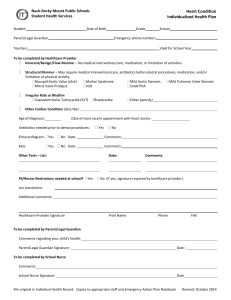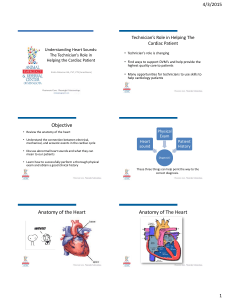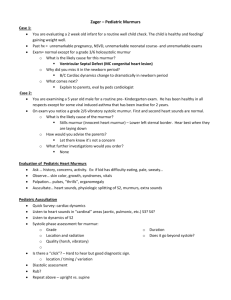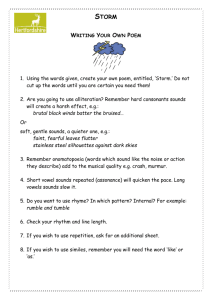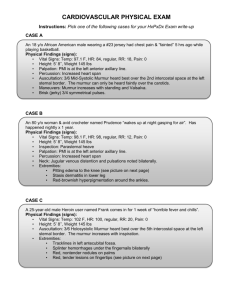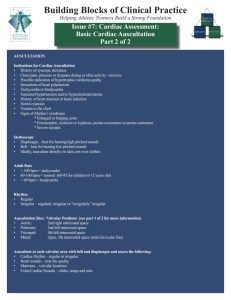CARDIAC AND PULMONARY AUSCULTATION John D. Bonagura
advertisement
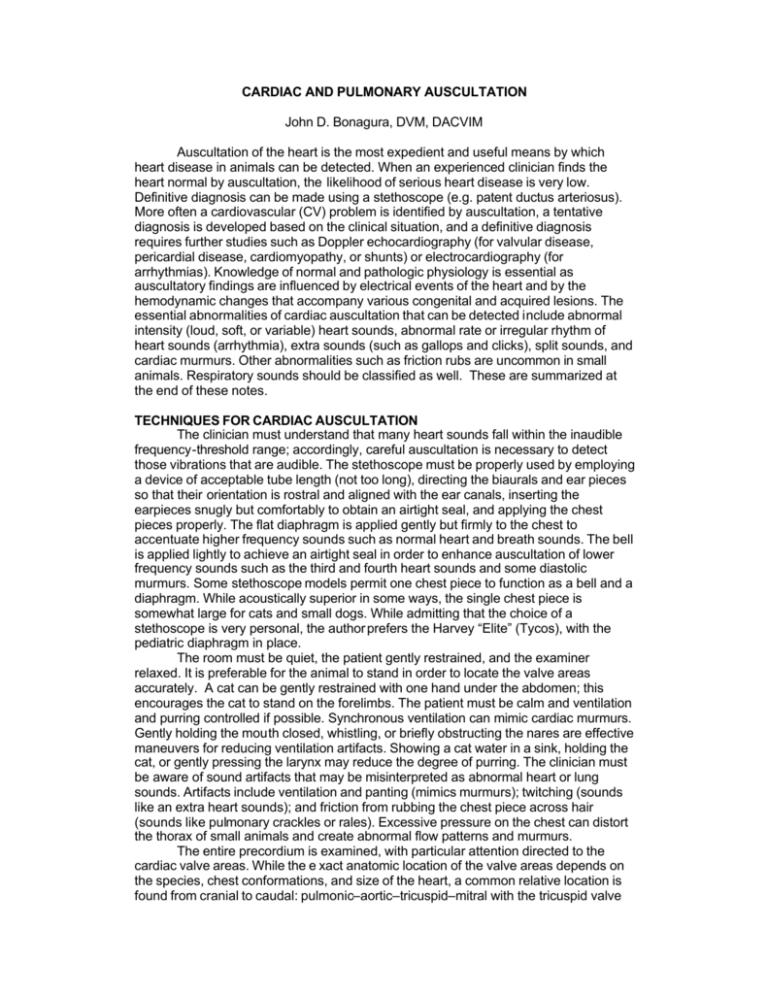
CARDIAC AND PULMONARY AUSCULTATION John D. Bonagura, DVM, DACVIM Auscultation of the heart is the most expedient and useful means by which heart disease in animals can be detected. When an experienced clinician finds the heart normal by auscultation, the likelihood of serious heart disease is very low. Definitive diagnosis can be made using a stethoscope (e.g. patent ductus arteriosus). More often a cardiovascular (CV) problem is identified by auscultation, a tentative diagnosis is developed based on the clinical situation, and a definitive diagnosis requires further studies such as Doppler echocardiography (for valvular disease, pericardial disease, cardiomyopathy, or shunts) or electrocardiography (for arrhythmias). Knowledge of normal and pathologic physiology is essential as auscultatory findings are influenced by electrical events of the heart and by the hemodynamic changes that accompany various congenital and acquired lesions. The essential abnormalities of cardiac auscultation that can be detected include abnormal intensity (loud, soft, or variable) heart sounds, abnormal rate or irregular rhythm of heart sounds (arrhythmia), extra sounds (such as gallops and clicks), split sounds, and cardiac murmurs. Other abnormalities such as friction rubs are uncommon in small animals. Respiratory sounds should be classified as well. These are summarized at the end of these notes. TECHNIQUES FOR CARDIAC AUSCULTATION The clinician must understand that many heart sounds fall within the inaudible frequency-threshold range; accordingly, careful auscultation is necessary to detect those vibrations that are audible. The stethoscope must be properly used by employing a device of acceptable tube length (not too long), directing the biaurals and ear pieces so that their orientation is rostral and aligned with the ear canals, inserting the earpieces snugly but comfortably to obtain an airtight seal, and applying the chest pieces properly. The flat diaphragm is applied gently but firmly to the chest to accentuate higher frequency sounds such as normal heart and breath sounds. The bell is applied lightly to achieve an airtight seal in order to enhance auscultation of lower frequency sounds such as the third and fourth heart sounds and some diastolic murmurs. Some stethoscope models permit one chest piece to function as a bell and a diaphragm. While acoustically superior in some ways, the single chest piece is somewhat large for cats and small dogs. While admitting that the choice of a stethoscope is very personal, the author prefers the Harvey “Elite” (Tycos), with the pediatric diaphragm in place. The room must be quiet, the patient gently restrained, and the examiner relaxed. It is preferable for the animal to stand in order to locate the valve areas accurately. A cat can be gently restrained with one hand under the abdomen; this encourages the cat to stand on the forelimbs. The patient must be calm and ventilation and purring controlled if possible. Synchronous ventilation can mimic cardiac murmurs. Gently holding the mouth closed, whistling, or briefly obstructing the nares are effective maneuvers for reducing ventilation artifacts. Showing a cat water in a sink, holding the cat, or gently pressing the larynx may reduce the degree of purring. The clinician must be aware of sound artifacts that may be misinterpreted as abnormal heart or lung sounds. Artifacts include ventilation and panting (mimics murmurs); twitching (sounds like an extra heart sounds); and friction from rubbing the chest piece across hair (sounds like pulmonary crackles or rales). Excessive pressure on the chest can distort the thorax of small animals and create abnormal flow patterns and murmurs. The entire precordium is examined, with particular attention directed to the cardiac valve areas. While the e xact anatomic location of the valve areas depends on the species, chest conformations, and size of the heart, a common relative location is found from cranial to caudal: pulmonic–aortic–tricuspid–mitral with the tricuspid valve on the right. A useful clinical pointer is to first palpate the left apex beat where mitral sounds radiate and the first heart sound is best heard. Find other valve areas from this point. The aortic valve area is located craniodorsal to the left apex and the second heart sound is best heard there. Once the aortic second sound is identified, the stethoscope can be moved one interspace cranial and slightly ventral (over the pulmonary valve area). The tricuspid valve is over the right hemithorax, cranial to the mitral area, and covers a relatively wide area. The pulmonary artery extends dorsally from the valve. The LV outlet is in the center of the heart and aortic murmurs usually radiate well to each hemithorax. Cardiac apex and cardiac base are commonly used expressions to designate the region ventral (ventricles) and dorsal to the atrioventricular groove. AV valve sounds often radiate ventrally towards the apex. Murmurs originating at the semilunar valves and great arteries are detected best over the base. TRANSIENT CARDIOVASCULAR SOUNDS Transient sounds are vibrations of short duration because their genesis depends on abrupt changes in blood flow and pressure. CV transient sounds, as well as cardiac murmurs, are timed relative to the first (S1) and second (S2) heart sounds. Following initial activation of the ventricles, the first sound is heard indicating the beginning of systole. At the end of ventricular ejection, the second sound is generated. The longer period between the second and ensuing first sound represents diastole to the clinician. Diastolic transient sounds, if present, are abnormal in small animals. Both S1 and S2 are relatively high -frequency sounds. The first is associated with the closure of the atrioventricular (AV); the second is caused by near-synchronous closure of the aortic and pulmonic valves. These sounds may be abnormal in certain conditions; for example: pericardial or pleural effusion or myocardial failure from dilated cardiomyopathy can decrease the intensity of the first heart sound. Arrhythmias lead to variable intensity heart sounds. Both heart sounds tend to be loud in healthy animals under high sympathetic drive or those with an ectomorphic conformation. Splitting of the sounds may be detected with asynchronous ventricular activation as with ventricular ectopia or bundle branch block. Severe pulmonary hypertension increases the intensity of S2 or leads to audible splitting of this sound should left and right ventricular ejection times become very disparate. The third and fourth sounds are lower-frequency sounds associated with vibrations that attend the termination of rapid ventricular filling and atrial contraction, respectively. These sounds indicate ventricular diastolic dysfunction when detected in dogs or cats. A third sound is typical of a ventricle with poor compliance that is filled under high venous pressures (as with mitral regurgitation or DCM and concurrent left-sided CHF). An atrial sound is typical of impaired ventricular relaxation (as with hypertrophic cardiomyopathy or myocardial ischemia . If both sounds are present and the heart rate is rapid, the gallops may be superimposed producing a summation gallop. Gallops may be the only auscultatory abnormality of cardiomyopathy and can vary with heart rate and filling pressures. Clicks are high pitched, systolic transient sounds. Mid-systolic clicks are not uncommon in dogs with mitral or tricuspid valve disease and are probably indicative of prolapse from abnormal chordae tendineae or valve redundancy. Isolated clicks suggest mild disease though clicks are often superimposed over murmurs in dogs with advanced mitral endocardiosis. Ejection clicks are infrequently detected with valvular pulmonic stenosis. Thus, the differential diagnosis for “extra sounds” should include gallops (atrial and ventricular) and clicks as well as split sounds and premature beats. Although a cardiac murmur is often considered the hallmark auscultatory finding in heart disease, some CV conditions may not be associated with a heart murmur. However, transient sounds may be abnormal in these patients and the clinician should be vigilant for these abnormalities. For example, cardiac murmurs are either inconsistent or absent in: tetralogy of Fallot with pulmonary artery hypoplasia and polycythemia; pericardial diseases (one may note distant or muffled heart sounds with pericardial effusion; an early diastolic ‘knock’ of restricted filling in constrictive pericardial disease; or (rarely) a friction rub in pericarditis); heartworm disease or other causes of pulmonary hypertension (may cause a loud, single, second heart sound, or even a split S2 if there is cardiac failure or right bundle branch block); systemic hypertension (a gallop may be the major feature of hypertensive heart disease; the second sound may also be prominent); and cardiomyopathy (though gallops and arrhythmias are common). Auscultatory findings of abnormal heart rate, irregular cadence, irregular intensity of the heart sounds, extra or absent heart sounds, or splitting of S 1 or S 2 should alert the clinician to a possible rhythm or conduction disturbance. (These findings indicate the need for an ECG.) CARDIAC MURMURS Cardiac murmurs are prolonged audible vibrations. Murmurs frequently indicate heart disease; however, many heart murmurs are innocent or functional (i.e. the heart is structurally normal). Murmurs are often associated with high velocity blood flow (typically > 1.6 m/sec) or with fluid vibrations that develop about disturbed or turbulent flow. Turbulence tends to develop when the velocity of flow incre ases or the viscosity of blood decreases. Turbulence is also more likely when blood enters a large vessel or chamber. Common clinical causes of cardiac murmurs include: 1) sympathetic stimulation as with exercise, fever, or hyperthyroidism (which can increase the velocity of ejection into the great vessels and can also lead to dynamic ventricular outflow tract obstruction); 2) anemia (which decreases viscosity of blood and is also associated with increased sympathetic drive); 3) flow into dilated vessels (especially those that abruptly change in diameter); 4) increased flow volume across otherwise normal heart valves; and 5) abnormal paths of blood flow from high to low pressure. Examples of high velocity flow across otherwise normal heart valves include atrial and ventricular septal defects (increased flow across the pulmonary valve) and complete AV block (increased flow across the aortic valve due to increased stroke volume and lower aortic diastolic pressure). Pathologic causes of increased velocity flow include stenotic valves, incompetent valves, ventricular septal defects, and aortic to pulmonary shunts (PDA). Heart murmurs are often detected in cats with dilated aortas related to either hypertension or degeneration (aortic redundancy). Dynamic right ventricular outflow tract obstruction has been proposed as another cause of ejection murmurs in stressed cats. Hypovolemia can also predispose to dynamic outflow tract obstruction and murmur development. Cardiac murmurs should be described based on timing, intensity, point of maximal intensity (PMI), radiation, pitch and quality. The timing of the murmur is systolic, diastolic, continuous, or to-and-fro (systolic – diastolic). The intensity of the murmur is arbitrarily graded on a 1-6 scale; we use the following convention: Grade 1 = a very soft, localized murmur detected only in a quiet room after minutes of intense listening. Grade 2 = a soft murmur, heard immediately, localized to a single valve area. Grade 3 = a moderate intensity murmur that is evident at more than one location. Grade 4 = a moderate intensity to loud murmur; radiates well; but a consistent precordial thrill is not present. Grade 5 = a loud murmur accompanied by a palpable precordial thrill. Grade 6 = a loud murmur with a precordial thrill, audible when the stethoscope is removed from the thorax. The point of maximal intensity is communicated by indicating the location, valve area, intercostal space where the murmur is loudest. A murmur usually projects from the PMI in the direction of abnormal blood flow. Murmurs can also radiate through solid structures (e.g. down to the apex). The radiation of a loud cardiac murmur can be extensive. Pitch, quality, and configuration pertain to the frequency and subjective assessment of the murmur by the examiner. Murmurs consisting of one fundamental frequency with overtones are described as “musical”, whereas murmurs of mixed frequencies are typically noted to be “harsh.” Most murmurs are of mixed frequency. The timing within the cardiac cycle, development, and murmur intensity create an impression of the murmur’s “shape” that might be recorded graphically by a phonocardiogram. Ejection murmurs are typically crescendo -decrescendo whereas regurgitant murmurs are longer (holosystolic or pansystolic) and plateau shaped. Functional murmurs are not associated with any obvious cardiac pathology. Innocent murmurs in puppies should abate by the rabies vaccination. Physiologic murmurs are functional murmurs related to altered physiologic state and include those of the athletic heart, anemia, fever, high adrenergic tone, peripheral vasodilation, hyperthyroidism, and marked bradycardia. Most physiologic murmurs are ejection in timing and detected best over the aortic and pulmonic valves and the great vessels (at the left dorsocranial cardiac base). Systolic murmurs heard over the right cranial sternal edge are common in cats, and probably represent functional murmurs from flow into a dilated aorta or due to dynamic RV outflow tract obstruction. Mitral regurgitation is one of the most common flow disturbances responsible for a pathologic systolic heart murmur. MR develops secondary to malfunction of any portion of the mitral apparatus. Causes include: congenital mitral dysplasia, degenerative valve disease (endocardiosis or prolapse) in the dog, bacterial endocarditis, myocardial disease, redundancy or rupture of a chorda tendineae (in the dog), and causes of left ventricular dilatation or hypertrophy, such as cardiomyopathy, hyperthyroidism, systemic hypertension, and PDA. This murmur is prominent over the mitral valve area and transmits prominently down to the left apex where it is often loudest (near the left sternal edge in cats). MR murmurs radiate both dorsally and to the right (usually one grade softer on the right hemithorax). The MR murmur can be decrescendo in peracute leakage (from equilibration of LV-LA pressures) or in mild cases (as the regurgitant orifice closes in late systole). The murmur can be very soft in hypotensive patients; alternatively, hypertension can increase the intensity. The musical systolic “whoop” is a striking frequency phenomenon in some dogs. Progressive increase in the intensity of the first heart sound is a unique feature of MR in dogs with endocardiosis probably ind icating cardiac dilatation with maintenance of left ventricular contractility; furthermore, the intensity of the MR murmur increases with the degree of valvular incompetency (assuming normal ABP). The intensity of the murmur in other causes of MR is not as reliably correlated to the severity. Cats with hypertrophic cardiomyopathy may have a labile murmur of MR related to dynamic left ventricular outflow tract obstruction and systolic anterior motion of the mitral valve. Tricuspid regurgitation is a common cardiac murmur. Much of what was stated concerning mitral regurgitation is applicable here. Causes include valve malformation, endocardiosis, valve degeneration, right ventricular enlargement (pulmonic valve stenosis, right sided cardiomyopathy, chronic b radycardia, pulmonary hypertension), dirofilariasis, and rarely tricuspid endocarditis. The PMI of this murmur is the tricuspid valve area and dorsal radiation is typical. The following support concurrent TR in the setting of MR: a prominent jugular pulse, right precordial thrill, different frequency murmur than that heard at the left side, or right sided CHF. Ventricular septal defect is probably the most common congenital heart malformation of cats, and also occurs with some frequency in dogs. A large nonrestrictive VSD (i.e., no substantial pressure difference between the ventricles) is also part of the tetralogy of Fallot. When the defect communicates the left ventricular outlet with the perimembranous ventricular septum or the right ventricular inlet septum, the murmur is loudest just below the tricuspid valve, along the right sternal border. When the defect communicates the left ventricular outlet with the RV outlet septum, the murmur may be most prominent over the craniodorsal left cardiac base. If the aortic valve has prolapsed into the ventricular septal defect, there may be a diastolic murmur of aortic regurgitation. Aortic stenosis is most common in dogs as a congenital, subvalvular, fibrous obstruction in the left ventricular outflow tract. The lesion may extend to involve the base of the aortic valve. The valve may be both stenotic and mildly incompetent. Other causes of LV outflow obstruction are hypertrophic cardiomyopathy or mitral valve malformation as these conditions can cause dynamic outflow obstruction. Bacterial endocarditis of the aortic valve causes aortic regurgitation before the vegetation is large enough to obstruct the valve. Cases of isolated, congenital, aortic valvular stenosis are seen sporadically. The murmur of AS is flow dependent, crescendodecrescendo in configuration, and like most ejection murmurs, becomes louder following exercise, inotropic stimulation, a ventricular premature beat, and increases in venous return. When intense, this murmur can be loudest over the right dorsal cardiac base owing to radiation of the murmur up the ascending aorta. The murmur tends to radiate up the carotids and even up to the head. A diastolic murmur of aortic regurgitation may develop leading to a to-and -fro murmur of AS/AR. Pulmonic valve stenosis is a congenital malformation of the valve characterized by valve thickening, varying degrees of leaflet fusion, hypoplasia, and thickening at the valve base. It is most common in dogs (uncommonly found in cats). The systolic crescendo -decrescendo murmur is heard best over the pulmonic valve (left 2 -3rd ICS) and radiates prominently in a dorsal direction into the post-stenotic dilatation of the main pulmonary artery. Thus, the murmur tends to be heard very well at the dorsal, left, cardiac base. Valvular PS also may be associated with an early systolic ejection click (fused valve) or a murmur of TR caused by secondary right ventricular enlargement. Following balloon catheter valvuloplasty there may be sufficient pulmonary insufficiency to create an audible diastolic murmur. Aortic regurgitation is the most important diastolic cardiac murmur. Causes include bacterial endocarditis, congenital aortic valve disease, prolapse of an aortic valve cusp into a subaortic ventricular septal defect, and aortic root dilatation in aged cats. This murmur is a long, diastolic, decrescendo murmur heard best over the aortic valve at the left hemithorax. The murmur is also well heard at the right cardiac base. Otherwise, diastolic murmurs are rare in dogs and cats. The soft, low-pitched rumble of congenital mitral or tricuspid stenosis is very rare (as are these conditions). There is often concurrent valvular regurgitation, which may lead to a systolic murmur. Patent ductus arteriosus is the most important cause of a continuous murmur and is described as “distant” and “machinery” (like a machine shop) in quality. The murmur must be carefully located dorsally on the cranial left base, over the main pulmonary artery (which is the sink for the shunt). Often there is concurrent mitral regurgitation (due to left ventricular dilatation) which may be responsible for a systolic murmur over the left apex. The stethoscope should be “inched” up and back to the PMI of the continuous murmur at the left base. Continuous murmurs (bruits) may also be detected over congenital or acquired arteriovenous fistulas, including those associated with thyroid carcinomas or limb injuries. RESPIRATORY SOUNDS Normal respiratory sounds include vesicular and bronchovesicular sounds, bronchial breathing, and tracheal sounds (panting). Normal sounds may become accentuated or decreased in diseases of the thorax or in CHF. An increase in bronchial sounds is often detected as a nonspecific finding of pulmonary disease including pulmonary edema. Decreased sounds may indicate pleural fluid (ventral fluid line) or air. Displaced sounds may indicate a mass lesion or diaphragmatic hernia. Normal sounds and abnormal (adventitious) sounds may only become evident after enforcing deeper breathing which can be encouraged by closing the mouth and holding off one nostril or by occluding both nostrils for a brief period to encourage deep breaths or sighs. Abnormal upper airway sounds include: 1) tracheal snaps which may be heard in tracheal collapse; 2) stertor (inspiratory snoring) typical of pharyngeal or nasopharyngeal diseases, and 3) stridor, an inspiratory wheeze over the larynx, that is typical of upper airway obstruction. Low-pitched inspiratory noise may also indicate upper airway obstruction. Abnormal lower airway (adventitious) sounds include rhonchi, wheezes, and crackles. A sonorous rhonchus is an inspiratory or expiratory noise (r/o transmission of upper respiratory stertor) which suggests the presence of fluid or exudate in larger airways, as with bronchitis or pneumonia. Wheezes (sibilant rhonchi) are high-pitched expiratory sounds typical of bronchial narrowing. The usual associations are bronchial disease (bronchitis, asthma) or attenuation of a main bronchus caused by left atrial dilation, hilar lymphadenopathy, primary bronchial collapse, or a pulmonary mass lesion. Crackles (“rales”) are discontinuous sounds similar to radio static or the sound of Velcro pulled apart. These sounds are caused by the explosive opening of collapsed small airways. Though there is a tendency to relate these to “fluid in the lungs,” there is not a consistent correlation as crackles may be detected with pulmonary edema, pneumonia, bronchitis, or pulmonary fibrosis. The loudest crackles are typically detected in primary lung diseases. Subtle crackles are evident only after a deep breath. Selected References Constable, P.D., Hinchcliff, K.W., Olson, J., and Hamlin, R.L. Athletic heart syndrome in dogs competing in a long- distance sled race. J Appl.Physiol. 1994; 76:433 -438. Detweiler, D.K. and Patterson, D.F. A phonograph record of heart sounds and murmurs of the dog. Ann.N.Y.Acad.Sci. 1965; 127: 22 -340. Detweiler, D.K. and Patterson, D.F. Abnormal heart sounds and murmurs of the dog. Journal of Small Animal Practice 1967; 8:193 -205. Haggstrom, J., Kvart, C., and Hansson, K. Heart sounds and murmurs - changes related to severity of chronic valvular disease in the cavalier King Charles spaniel. J Vet Internal Med. 1995; 9:75-85. Smetzer, D.L., Hamlin, R.L., and Smith, C.R. Cardiovascular sounds. In: Dukes' Physiology of Domestic Animals, edited by Swenson, M.J.Ithaca:Comstock Publishing Company, Inc. 1970, p. 159-168. Smetzer, D.L. and Breznock, E.M. Auscultatory diagnosis of patent ductus arteriosus in the dog. J.Am.Vet.Med.Assoc. 1972; 160:80.
